Urinary tract infection diagnostic
a technology for urinary tract infections and diagnostics, applied in the direction of instruments, ict adaptation, peptide/protein ingredients, etc., can solve the problems of urinary tract bloody appearance, unhelpful methods in most situations,
- Summary
- Abstract
- Description
- Claims
- Application Information
AI Technical Summary
Benefits of technology
Problems solved by technology
Method used
Image
Examples
example 1
of Biomarkers
[0232]Samples were collected as part of an 141 funded project, whereby a total of 189 urine samples from adult women presenting with suspected uncomplicated UTI were fully analysed with respect to 60 biomarkers.
[0233]There were two objectives:[0234]i. To define a panel of biomarkers to distinguish between negative and positive culture[0235]ii. To select a biomarker that provided the best discrimination between the suspected UTI samples and those from patients who have recovered (healthy).
[0236]In order to distinguish between patients presenting with different types of infection, binary logistic regression was used to predict which biomarkers are significant for outcome on their own, without interaction with other parameters. The markers that were significant in this analysis were then analysed further using the Stuttgart Neural Network Simulation (RSNNS) in R where the biological markers significant on their own were weighed against each other and interactions taken int...
example 2
nt of Lateral Flow Assays
[0246]The three selected biomarkers HNE, MMP8 and Cystatin C were taken forward for lateral flow development. The three lateral flow assays were developed and optimised enclosed into a single well plastic housing supplied by Bibby sterylin using a standard lateral flow form.
HNE Lateral Flow
[0247]Preparation of materials: The capture line, anti-HNE BSA-PEG Fab (Alere San Diego, Cat No 01241) and control line BSA-Biotin were immobilised onto the nitrocellulose membrane (Sartorius, CN140) at 1 mg / mL in PBS+1% Sucrose using the Imagene Isoflow dispenser. Membranes were subsequently dried in a tunnel dryer (Hedinair) at 60° C. and stored with desiccant prior to use.
[0248]The gold conjugates were prepared according to known protocols. Anti-HNE BSA-PEG Fab (Alere San Diego, Cat No 01871) was conjugated to 40 nm gold colloid in a suspension buffer of 20 mM MES pH5.3 to a final concentration of 15 μg / mL. Following a 10-minute incubation, any unbound colloid was block...
example 3
al Analysis and Algorithm Development
[0262]In the Cardiff POETIC study (Bates 2014), 424 samples were collected in total: 204 were from a visit 1 and 220 were from a visit 2 samples (not all of these were matched samples). There were 93 matched visit 1 and visit 2 samples in total.
[0263]Sample information was available for a total of 194 samples; 175 from a visit 1 and 19 from a visit 2 samples. Of the 93 matched samples, 81 of the visit 1 samples had accompanying clinical information.
[0264]From the 81 visit 1 samples, 32 of the samples were UTI positive and 49 were UTI negative. The status was based on the microbiology results:[0265]No growth=No growth found[0266]No significant growth=growth of pure isolate 5 [0267]Mixed 2 orgs=Growth of 2 orgs at 105 cfu / mL or more[0268]Mixed>2 orgs=Growth of 3 or more isolates at 105 cfu / mL or more[0269]POS=either a pure growth at 105 cfu / mL or more OR a growth of a predominant isolate at 105 or more with growth of other isolates at 3×log 10 less...
PUM
| Property | Measurement | Unit |
|---|---|---|
| Time | aaaaa | aaaaa |
| Time | aaaaa | aaaaa |
| Time | aaaaa | aaaaa |
Abstract
Description
Claims
Application Information
 Login to View More
Login to View More - R&D
- Intellectual Property
- Life Sciences
- Materials
- Tech Scout
- Unparalleled Data Quality
- Higher Quality Content
- 60% Fewer Hallucinations
Browse by: Latest US Patents, China's latest patents, Technical Efficacy Thesaurus, Application Domain, Technology Topic, Popular Technical Reports.
© 2025 PatSnap. All rights reserved.Legal|Privacy policy|Modern Slavery Act Transparency Statement|Sitemap|About US| Contact US: help@patsnap.com



